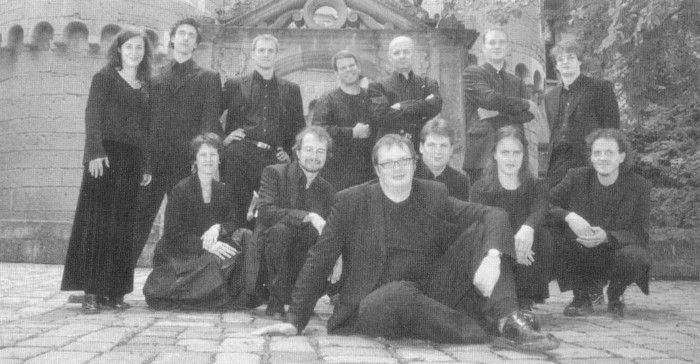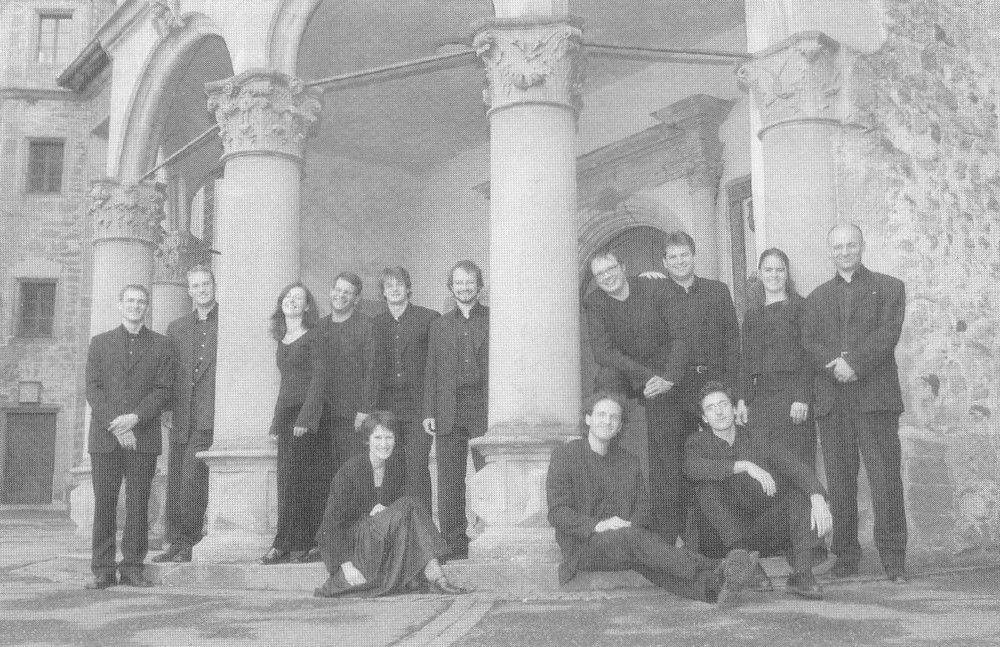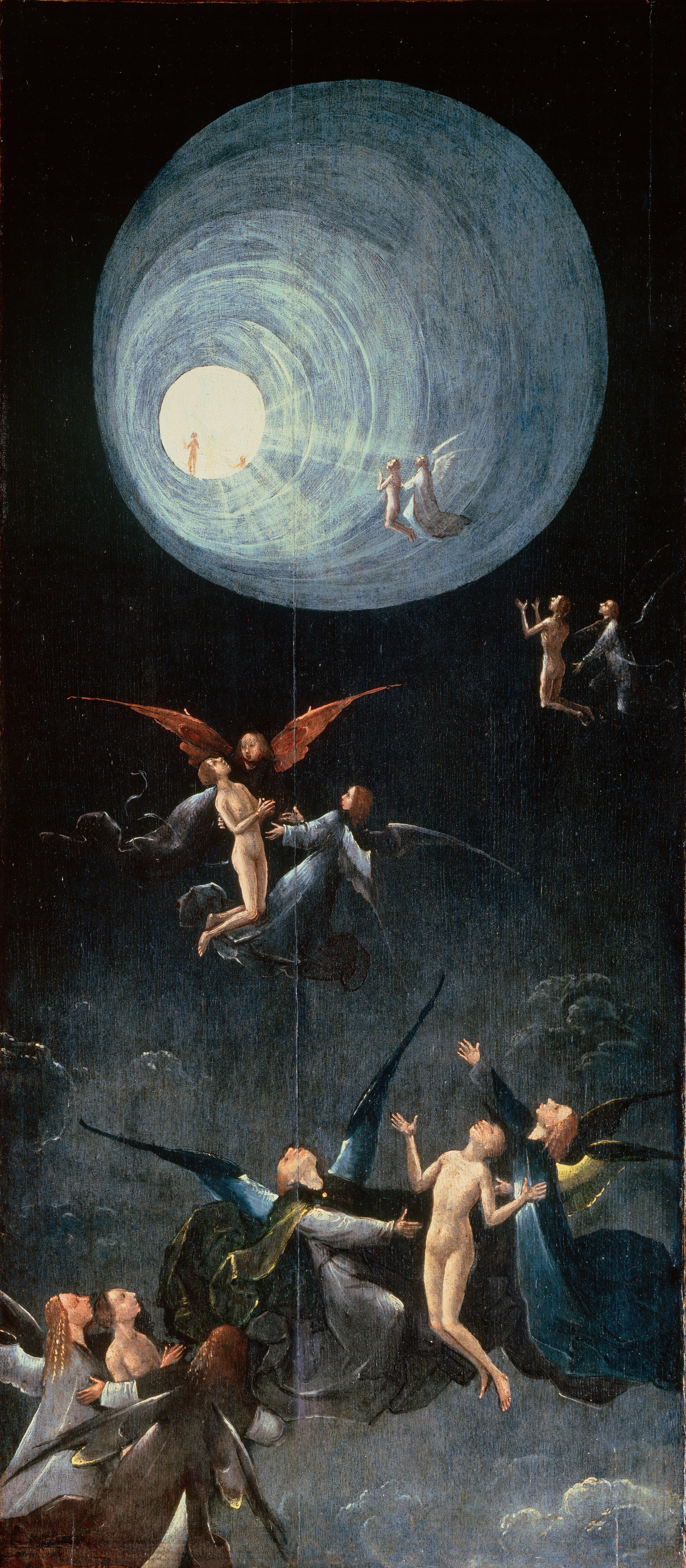Missa pro defunctis · Missa De Beata Virgine
Pierre de LA RUE / Ensemble Officium

medieval.org
Christophorus CHR 77268
2004
Pierre de LA RUE
(c.1460-1518)
Missa pro defunctis
1. Introitus. Requiem [3:47]
2. Kyrie [2:14]
3. Psalmus. Sicut servus [3:15]
4. Offertorium. Domine Jesu Christe [4:52]
5. Sanctus [4:05]
6. Agnus Dei [2:50]
7. Communio. Lux aeterna [2:48]
Missa de Beata Virgine
8. Introitus. Salve sancta parens ·
gregorianisch [2:17]
9. Kyrie [3:00]
10. Gloria [4:34]
11. Graduale. Benedicta et venerabilis ·
gregorianisch [4:42]
12. Credo [6:32]
13. Offertorium. Recordare Virgo Mater ·
gregorianisch [1:35]
14. Sanctus [5:33]
15. Agnus Dei [5:11]

ENSEMBLE OFFICIUM
Wilfried Rombach
Sopran:
Marion E. Herbst (Solo), Christine Rombach, Sibylle Henn [1-9,
11,13,16],
Leila Finvik Pettersen [1-9, 11,13,16], Miriam Barth [8-16], Berenike
Lisker [10-15]
Tenor:
Achim Plagge (Solo), Jörg Rieger (Solo), Gerhard Hölzle [1-7],
Hans-Joachim Weber [2, 4-6], Stefan Weible [10,12,14,15], Torsten Krug
[10,12,14,15]
Bass:
Hartmut Petri (Solo), Daniel Herrscher [1-7], Alois Späth [2, 4-6],
Lemi Reskovac [1-6], Jens-Martin Ludwig [10,12,14,15]

Produzent: Gunilla Gustayson
Aufnahme: 2/2002 [7-15], 11/2003 [1-6]; Ev. Kirche Reutlingen-Gönningen
Aufnahmeleitung & Schnitt: Christoph Claßen
Redaktion: Joachim Berenbold
Überseungen: English · J & M Berridge / Français
· Sylvie Coquillat
Artist Photos: Simone Staren
Coverbild: Hieronymus Bosch «Der Flug zum Himmel» (c.1500,
Dogenpalast Venedig)
Gestaltung: Manfred Glaser
(P) + © 2004 MusiContact GmbH, Heidelberg, Germany
SACRED MUSIC AT THE COURT OF FREDERICK THE WISE
by Wilfried Rombach
 The Saxon elector Frederick the Wise (1463-1525) stood for
peaceful settlement and kept his realm free of armed conflict. But
Frederick has gone down in history mainly as the protector of reformer
Martin Luther and as a patron of the sciences and arts. He established
a university in Wittenberg in 1502, at which Luther, and Melanchthon
taught, and greatly enhanced the city by rebuilding the castle and the
associated church and maintaining a very proficient choir. In 1526, a
year after the elector's death, a chronicler had the following to say
about him:
The Saxon elector Frederick the Wise (1463-1525) stood for
peaceful settlement and kept his realm free of armed conflict. But
Frederick has gone down in history mainly as the protector of reformer
Martin Luther and as a patron of the sciences and arts. He established
a university in Wittenberg in 1502, at which Luther, and Melanchthon
taught, and greatly enhanced the city by rebuilding the castle and the
associated church and maintaining a very proficient choir. In 1526, a
year after the elector's death, a chronicler had the following to say
about him:
This elector of Saxony, Duke Frederick, so loved music that for many
years and a long time he kept a very large chapel of singers and often
took them with him to the imperial Diets. They were treated kindly and
paid well [...], and neither his Roman Imperial Majesty nor any other
prince or nobleman far and wide had anything comparable.
The choir comprised between twelve and eighteen singers as well as
several boys, all of whom took part in performing the Gregorian chant.
In this, it was modelled on the leading vocal collegia of the time, the
court chapels of Burgundy and of Emperor Maximilian I. In the period
centring around 1500, artistically inclined rulers actively vied for
the best court chapel and had ample opportunity to make comparisons. We
know, for example, that the choirs of both Maximilian and Frederick
were present at the Diet in Freiburg in 1498. The calibre of the court
chapel of Frederick the Wise may be judged by the repertoire the choir
performed at the beginning of Martin Luther's time in Wittenberg. The
eighteen extensive and in large part magnificently decorated
manuscripts of the Jena choir-books from the collection
of Frederick the Wise contain the most important polyphonic liturgical
compositions of Josquin Desprez (c. 1450-1521), Heinrich Isaac (c.
1450-1517) and many of their contemporaries, as well as most of the
settings of the mass by the likewise Franco-Flemish composer Pierre de
la Rue (c. 1460-1518). The compositions are in the mensural notation of
the late Middle Ages, the parts being divided according to the usual
positioning of the singers in Franco-Flemish choirs, the left-hand page
containing the descant and tenor parts, the right-hand page those of
the counter-tenors and basses. We do not know whether the majority of
the choir-books were acquired when Wittenberg Castle was rebuilt in
1498 or when the university was founded in 1502, but the overwhelming
predominance of La Rue's works in Frederick's court repertoire supports
the conclusion that their acquisition may be attributed to the
Wittenberg kapellmeister Adam Rener (1485-1520), who had contacts at
the court of Burgundy dating back to the time of his apprenticeship
there. After training at the court of Emperor Maximilian I and later at
the court of Burgundy, Rener succeeded Adam von Fulda and served the
Wittenberg court from 1507 until his early death in 1520. Adam Rener
made the court choir of Electoral Saxony one of the most important
court musical establishments of the early sixteenth century and was
himself unquestionably a major composer in the period around 1500. The
official conversion to the Protestant faith took place in Wittenberg in
1525 — the year in which Frederick died. The resulting drastic
reduction in the status of liturgical music led Frederick's successor
John the Steadfast to dissolve the choir two years later, making the
splendid choir-books redundant. Since 1549 they have been in the
possession of the Thuringian University and State Library in Jena
(Thüringer Universitäts- und Landesbibliothek Jena, ThULB).
Pierre de la Rue ranks with Josquin Desprez and Heinrich Isaac
among the most important musical personalities around 1500. As is the
case with many of his contemporaries, we do not know when or where this
great master of vocal polyphony came into the world. It is assumed that
he was born in about 1460 in the vicinity of Tournai (Doornik), close
to the French border in today's Belgium. He spent most of his life
singing in the Grande Chapelle of the Burgundian court in Brussels and
at the court chapel of Margaret of Austria in Mechelen, two of the most
prestigious ensembles in Europe at the time. Among the changing lords
La Rue served were the later Emperor Maximilian I and his wife Mary of
Burgundy, their son Philip the Handsome (whom La Rue accompanied on his
visits to Spain) and — after Philip's death — their
daughter Margaret of Austria. As regent of the Netherlands, Margaret
drew numerous artists to the Burgundian court in Mechelen. But her
favourite musician seems to have been Pierre de la Rue. After La Rue's
death in Courtrai (Kortrijk) on November 20, 1518, Margaret had
collections of his works compiled in two special manuscripts as a
conspicuous mark of the esteem in which she held him. Today in Brussels
and Vienna, they are among the most precious music manuscripts that
have come down to us from that era.
The Missa pro defunctis by Pierre de la Rue is found in
an exceptionally large number of sources and was clearly one of the
most famous requiem masses in the sixteenth century. It is found three
times in the choir-books of the Munich Hofkapelle alone, while it also
appears in the twelfth choir-book of the ThULB Jena (fol.111v-122r),
where (especially in the Communio) it deviates slightly from
other versions. Since the entire repertoire of the court choir of
Electoral Saxony contains only one other setting of the requiem mass
(by the much less well known Antoine de Févin), it is reasonable
to assume that La Rue's Requiem was performed at the funeral service
for Frederick the Wise in 1525.
The Requiem is one of Pierre de la Rue's greatest works, prominently
featuring his distinctive, densely interwoven polyphonic writing, the
complexity of which is particularly evident in the combination of
various metrical patterns in the Introitus and Kyrie
and also in the frequently two-part canonic texture found at the
beginning of the Psalmus and Offertorium. Most settings
of the mass are limited to the Kyrie, Gloria, Credo, Sanctus
and Agnus Dei sections of the ordinary. A Missa pro
defunctis, on the other hand, is a “plenary mass”,
which in addition to the Kyrie, Sanctus and Agnus Dei (Gloria
and Credo are sung only on Sundays and feast days), includes
the Introitus, Graduale (which La Rue calls Psalmus), Offertorium
and Communio. In accordance with liturgical conventions
reaching well into the sixteenth century, unison melodies of Gregorian
chant form the basis of the individual sections. They preface each
section in the form of an introductory initium and are also worked into
them in long notes as a cantus firmus — in the soprano in the
case of the introduction to the Sanctus, or in the tenor, as in
the Agnus Dei. This technique of setting plainsong was seen as
a yardstick for assessing a composer's mastery in the fifteenth and
sixteenth centuries. The main problem for modern performers lies in the
unaccustomed chiavette convention — the use of varied
clefs. The Introitus, Kyrie and Agnus Dei are set in
lower clefs (down to contra B flat in the bass), while the Psalmus
and Communio are set in higher ones. For the present recording,
all the sections were given a transposition that corresponds with the
character of the piece and also enables the Gregorian cantus firmus to
be performed.
Founded by Frederick in 1502, the University of Wittenberg would soon
become the cradle and intellectual centre of the Reformation and be
reliably protected by the elector — if only in a discreet,
indirect way. However, before Martin Luther came onto the scene,
Wittenberg was dominated by late-medieval piety. Frederick's rules for
the collegiate church for the years 1509 and 1512 paint a picture of
richly appointed church services at his court. Following the general
European custom, adoration of the Virgin Mary, mother of the Saviour,
was in the foreground. In addition to the normal mass dedicated to the
saint of that day, a second mass was celebrated each day in honour of
the Virgin. On Sundays it related to the Immaculate Conception, on
Mondays to Mary's birth, on Tuesdays to her Presentation in the Temple,
on Wednesdays to the Annunciation, on Thursdays to the Visitation, on
Fridays to her Seven Sorrows or Purification and on Saturdays to her
Assumption. In view of this, the repertoire of the Wittenberg court
choir includes numerous settings of the mass in honour of Mary. Works
by Josquin Desprez and Heinrich Isaac are there, while choir-book no.
22 of the ThULB Jena contains a Missa de Beata Virgine
by Pierre de la Rue (fol.18v-29r). Presumably from c. 1500, the
large-format parchment manuscript contains thirteen settings of the
mass, eight of them by Pierre de la Rue. The Misas de Beata Virgine
derives, as was usual at that time, from a Gregorian model, the Misse
Cum Jubilo (Vat. IX) normally used at Marian festivals. The Gloria
and Benedictus moreover contain the then customary extensions
of the usual text that turn to the Virgin Mary as intercessor.
In keeping with the age in which he lived, Pierre de la Rue wrote
polyphonic settings into his Misse de Beata Virgine only for
the sections making up the Ordinary, leaving the sections making up the
Proper to be performed in plainsong in the customary way. This
recording follows the same principle. We have used the Gregorian Proper
Salve Sancta parens, a common votive mass for the Virgin,
together with the similarly named Gregorian Introitus, the
responsory Graduale, an Offertorium and Communio
with their verses from the psalms. These Gregorian additions follow the
manuscript of the gradual from the thirteenth or fourteenth century at
St Thomas's Church in Leipzig (Th371), which represents one of the most
important sources of the Germanic variant of plainchant. The precious
manuscript was lost in the Second World War, but a published
photographic facsimile of it fortunately exists. Its chronological and
geographic proximity make it safe to assume that it approximates the
form of plainchant used in Wittenberg in the early sixteenth century.
Its incorporation into La Rue's work serves to provide a complete and
diversified picture of how a mass in honour of Mary was performed at
the time of the Saxon Elector Frederick the Wise.




 The Saxon elector Frederick the Wise (1463-1525) stood for
peaceful settlement and kept his realm free of armed conflict. But
Frederick has gone down in history mainly as the protector of reformer
Martin Luther and as a patron of the sciences and arts. He established
a university in Wittenberg in 1502, at which Luther, and Melanchthon
taught, and greatly enhanced the city by rebuilding the castle and the
associated church and maintaining a very proficient choir. In 1526, a
year after the elector's death, a chronicler had the following to say
about him:
The Saxon elector Frederick the Wise (1463-1525) stood for
peaceful settlement and kept his realm free of armed conflict. But
Frederick has gone down in history mainly as the protector of reformer
Martin Luther and as a patron of the sciences and arts. He established
a university in Wittenberg in 1502, at which Luther, and Melanchthon
taught, and greatly enhanced the city by rebuilding the castle and the
associated church and maintaining a very proficient choir. In 1526, a
year after the elector's death, a chronicler had the following to say
about him: